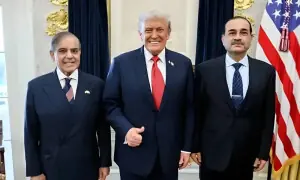Finance Minister Aurangzeb unveils Rs18.87 trillion budget amid opposition noise
Highlights
- Aurangzeb thanks heads of PPP, MQM-P as well as Nawaz and Shehbaz
- Says govt wants to decrease expenditure, including pension
- Lauds economic performance in last year
- Calls next year ‘time for reform’
Finance Minister Muhammad Aurangzeb presented the budget for fiscal year 2024-25 in the National Assembly on Wednesday.
Aurangzeb said that the GPD growth target has been set at 3.6%, inflation at 12% and budget deficit at 5% of GDP.
He also said that FBR’s collection target has been set at Rs12,700 billion. Of this, over Rs7,000 billion will be contributed by provinces.
The minister said that RsRs3,587 billion would be gained from non-tax revenue.
He said that the total development budget would be a historic-high at Rs1,500 billion and defence spending would be Rs2,122 billion.
Aurangzeb said Rs839 billion would be dedicated to civil administration. He said that Rs1,363 billion would be reserved for subsidies including energy.
The federal govt would have an income of Rs9,119 billion, he added. The government’s total expenses were estimated to be Rs18,877 billion of which Rs9775 billion will be go to interest payments
At the beginning of his speech, he said that PM Shehbaz Sharif had set the tone for a homegrown reform agenda.
“We have to increase the pace of development and work hard on a homegrown reforms plan, which was introduced by Nawaz in the past,” he said.
He said that inflation has been on the decline in Pakistan and essential items are slowly coming back into the common man’s reach. He added that the successes achieved in the past year were nothing short of remarkable.
Members of the opposition started protesting as Finance Minister Muhammad Aurangzeb started delivering his budget speech.
“We will return to inclusive and sustained growth soon, this is a time for reform,” he added. He went on to say that the private sector must be given a bigger role.
He added that a massive burden had been put on the state, creating a low-growth cycle.
“We need to go from a government-driven to market-driven model,” he added. He also said that a broad taxation base was needed. He added that Pakistan’s economic progress should be investment and savings-based rather than consumption-based.
“Decreasing the budget deficit will be important, for this the government will form an equal tax policy that will increase our income and decrease unnecessary expenses, he added.
Aurangzeb said that no decreases will be made to measures for climate change resistance.
He said that over 40,000 traders have been brought into the tax net and FBR will continue to expand the tax net.
The minister said that the government was introducing reforms in the pension system and the government would also take measures to decrease its expenses. He added PM Shehbaz had already announced that PWD was being abolished.
Aurangzeb said that he believed that governments should not conduct business. He added that the privatisation of multiple SOEs including PIA was already underway and the plan would be expanded later.
He also confirmed that multiple airports will be outsourced beginning with Islamabad International Airport.
Aurangzeb that a contributory pension system will be introduced to manage pension expenses.
He also announced that BISP cash transfers will be increased in amount as the program is the cornerstone of the government’s social protection program. He said that the program’s funding would be increased by 27%.
The minister said that agriculture was the main force driving the economy and the government wanted to take advantage of private investment to boost this sector.
Aurangzeb said that the government wanted to cut line losses and introduce private sector professionals into DISCOs.
He added that special attention would be paid to the IT sector to take IT exports to $3.5 billion.
He also said that Rs206 billion would be dedicated to water resources and related projects.
The minister said that the government values overseas Pakistanis and will work to make immigration easier through various measures including setting up a hotline.
He said that the budget proposed an increase in the export support budget from Rs3.8 billion to Rs13 billion.
Aurangzeb said that SIFC was leading the effort to bring investment from GCC countries and the PM had recently visited China to kick off phase 2 of CPEC.
“In order to expedite business investment and increase exports, easing the regulatory framework is most important. For this, the Pakistan regulatory modernisation initiative has been started to ease the govt regulatory framework and improve the business environment via automation to increase exports and pace of investment.”
He mentioned e-procurement is set-up in 37 ministries and 289 procuring agencies. By this, he said the federal govt has made Rs14b worth of procurement.
Challenging revenue target
Pakistan has set a challenging tax revenue target of Rs13 trillion for the year starting July 1, a near 40% jump from the current year, in its national budget on Wednesday that looked to strengthen the case for a new bailout deal with the International Monetary Fund (IMF).
The ambitious revenue targets for the fiscal year through June 2025, presented by Finance Minister Muhammad Aurangzeb in parliament, were in line with analyst expectations. Total spending was 18.87 trillion rupees ($68 billion).
Key objectives for the upcoming fiscal year include bringing the public debt-to-GDP ratio to sustainable levels and prioritising improvements in Pakistan’s balance of payments position, the government’s budget document showed.
Pakistan has projected a sharp drop in its fiscal deficit for the new financial year to 5.9% of GDP, from an upwardly revised estimate of 7.4% for the current year.
Pakistan will look to widen the tax base to avoid burdening existing taxpayers to meet its targets, Aurangzeb said.
“The budget has a significant increase in tax burden this year,” said Vaqar Ahmed of the Sustainable Development Policy Institute think-tank, adding that because of the large informal segment of the economy, the burden will fall on the existing sectors.
‘INFLATIONARY IMPACT’
“The tax burden will have an inflationary impact as well,” Ahmed said.
On Monday, the central bank warned of possible inflationary effects from the budget, saying limited progress in structural reforms to broaden the tax base meant increased revenue must come from hiking taxes.
The bank, in a bid to boost growth, cut interest rates for the first time in four years on Monday, slashing them by 150 basis points, in the face of a sharp decline in inflation from a high of 38% last year to 11.8% in May.
GDP would expand 2.4% in the current year, missing the budgeted target of 3.5%, the government said, despite revenues rising 30% on the year, and the fiscal and current account deficits being under control.
The upcoming year’s growth target has been set at 3.6% and inflation projected at 12%, Aurangzeb said.
RAISING REVENUE
Pakistan had to find ways to increase its revenues to reduce its fiscal deficit as part of reforms being discussed with the IMF.
Pakistan is in talks with the lender for a loan of $6 billion to $8 billion, as it seeks to avert a default for an economy growing at the slowest pace in the region.
The rise in the tax target is made up of a 48% increase in direct taxes and 35% hike in indirect taxes over revised estimates of the current year. Non-tax revenue, including petroleum levies, is seen increasing by a whopping 64%.
Aurangzeb said sales tax would increase to 18% on textile and leather products as well as mobile phones. He also announced a hike in the tax on capital gains from real estate.
Following is the breakup of resources and expenditures:
-
Total expenditure: Rs18,877 billion
-
Tax revenue (FBR) – Federal Consolidated Fund: Rs12,970 billion
-
Non-Tax Revenue: Rs4,845 billion
-
a) Gross Revenue Receipts: Rs17,815 billion
-
b) Less Provincial Share: Rs7,438 billion
-
I.Net Revenue Receipts (a-b): Rs10,377 billion
-
II. Non-Bank Borrowing (NSSs & Others) – Public Account: Rs2,662 billion
-
III. Net External Receipts – Fed. Consolidated Fund: Rs666 billion
-
VI. Bank Borrowing (T-Bills, PIBs, Sukuk) – Fed. Consolidated Fund: Rs5,142 billion
-
V. Privatisation Proceeds – Fed. Consolidated Fund: Rs30 billion
-
Total (II+III+IV+V): 8,500
-
Current: Rs17,203 billion
-
Interest Payments: Rs9,775 billion
-
Pension: Rs1,014 billion
-
Defence Affairs & Services: Rs2,122 billion
-
Grants and Transfers to Provinces & Others: Rs1,777 billion
-
Subsidies: Rs1,363 billion
-
Running of Civil Govt: Rs839 billion
-
Provision for Emergency and others: Rs313 billion
-
Development: Rs1,674 billion
-
Federal PSDP: Rs1,400 billion
-
Net Lending: Rs274 billion
For the latest news, follow us on Twitter @Aaj_Urdu. We are also on Facebook, Instagram and YouTube.


















Comments are closed on this story.